Introduction
"The Silver Shoes," said the Good Witch, "have wonderful powers. And one of the most curious things about them is that they can carry you to any place in the world in three steps, and each step will be made in the wink of an eye. All you have to do is to knock the heels together three times and command the shoes to carry you wherever you wish to go."
The silver shoes, in Frank Baum’s enduring fantasy masterpiece The Wizard of Oz, are far more than a plain prop that propels the plot forward. At the beginning of her whirlwind journey, Dorothy Gale comes into these magical silver shoes but is unaware of their true power or purpose. Nevertheless, lost but not alone, as she treads tentatively down a perilous passage, she finds resilience, reliability – and finally the revelation that the silver shoes she’s been wearing throughout the whole journey have this curious power to take her exactly where she wants to go!
There is certainly a curious power in being able to place learners in someone else’s shoes. In the digital learning space, when devising a learning approach to address skill gaps, instructional designers identify suitable methods that will maximize learner engagement during the learning process. The go-to methods to accomplish this in digital learning include infusing interactivity, incorporating quizzes, providing feedback, adding gamification, and creating a learning cohort so that learners can go on a learning journey together with other colleagues. While these methods of engagement are essential components comprised in any digital learning approach, designing training for soft skills development requires an even richer ingredient… something that moves the engagement needle from abstract conceptualization to concrete experience. It requires a learning approach that can immerse the learner in someone else’s shoes, via a scenario that bears verisimilitude to real life.
Significance of Scenario-Based Learning
In scenario-based learning, learners usually play the protagonist in a relatable story that contains a few ambiguous aspects. During the learning activity, learners work through grey areas at various decision points and make a few judgment calls. As the activity progresses, learners get to understand – through feedback loops – the effect and outcomes that their decisions have. They have a few Aha! moments along the way, and by the end of the activity, they will have had the opportunity to develop new perspectives both about themselves and their colleagues whom they frequently interact with.
What makes scenario-based learning effective is that it presents learners with a safe space to fail. Learners revel in the challenge and are hooked by the zigzagging paths they can take through the scenario. They also find the experience especially rewarding because they can go through the same scenario multiple times, choosing another character in the story the next time round. This helps them understand different sides of the same story.
Regardless of the learning tech stack your organization has available at hand, adopting this instructional approach for your soft skills training is bound to get you the best results your money can buy. Over the last couple of decades, we’ve had a surfeit of landmark technological innovations – the advent of Web 2.0, Flash-based courses (now defunct), mobile learning, HTML5, the introduction of Tin Can API, and the rise of Extended Reality (XR), Virtual Reality (VR), Augmented Reality (AR) and Mixed Reality (MR) solutions. All of these have been a big boon to digital learning and have given organizations opportunities to make their scenario-based learning increasingly immersive with each innovation. There’s also no denying that the more sophisticated and immersive the technology is, the greater the impact that the training will likely have on the learners.
It’s important to note that technological innovations are destined to go through their life cycle of R&D, growth, maturity, and eventual decline. So, if your organization is currently contemplating a learning technology upgrade, know that it’s important to catch an innovation at the right time. Jumping on the bandwagon too early, when there are still too many unknowns out there, would mean that your expenditure on working out the kinks could outweigh the returns on your investment. And, if you’re a little late in the cycle, it would mean that your investment would come with a fast-approaching expiry date. Riding the growth and maturity waves would be your best and safest bet. Our 2023 technology recommendation for scenario-based learning – from a freshness, feasibility, fun factor, and technology life cycle phase point of view – is Augmented Reality.
Here is an example of how you can imagine your next Diversity and Inclusion training in Augmented Reality.
Augmented Reality Scenario-Based Learning Experience

In our Diversity and Inclusion augmented reality learning experience, we have two characters, Nyara and Todd, who are colleagues working in a large tech company. Todd is a Vice President and Head of a product division and needs to have a position filled in his team, while Nyara is a Product Development Manager who helps with the hiring. There’s a bit of a stand-off between them as Todd appears to be inclined towards hiring someone he knows, while Nyara is conflicted about this as she feels inclined to honor the hiring process followed in their company and give all applicants a fair chance.
How it Works
Augmented Reality uses mobile devices to merge digital content into the real world. While Virtual Reality typically requires headsets, goggles, or some other extra equipment, all that Augmented Reality requires is access to the camera of the mobile device, and an Augmented Reality app.
Our app works on both Android and IOS mobiles and tablets. Depending on the device the learner is using, learners need to navigate to the Play Store or App Store and download and install the app. During installation, learners will need to grant certain permissions (to the camera, storage folder, and so on). Granting all permissions is safe and will ensure that the learning experience is uninterrupted.
The app overlays the learners’ real-world surroundings with digital data. When learners look at their environs displayed on their mobile device screens, they will also see graphical objects (characters and text) appear in their surroundings. The characters are animated and developed in 3D and are solid, colorful, and vibrant, and can be viewed from various angles on the mobile app. We also rig and skim our 3D characters for free animated movement.
When learners launch the app from their devices, they are first greeted by a character selection screen. They can choose to go through the learning experience either as the Head of the product division or as the Hiring Manager.
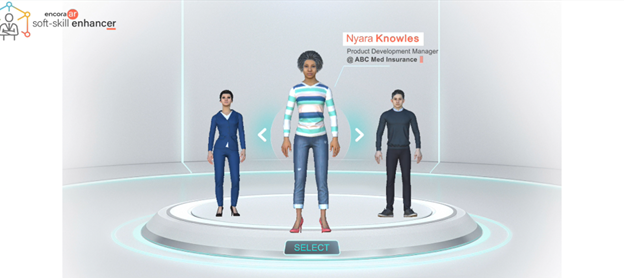
After selecting a character, the device camera turns on, and learners are asked to point their mobile/tablet towards a well-lit horizontal surface in their surroundings. Then, voila! Out pops the selected character right there in front of them! And the learning begins to roll…


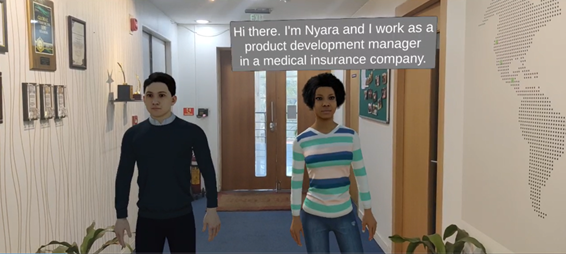
Learners get to see the characters and hear them share their predicaments and are then asked to choose what the best course of action would be at each stage. Each choice that learners make takes them down different paths. Learners experience the outcome (positive or negative) of their choices first-hand.
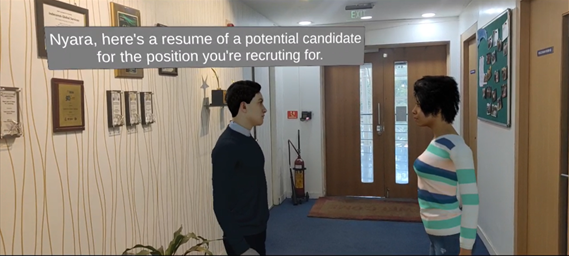
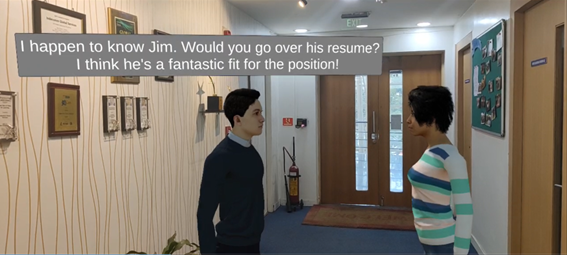
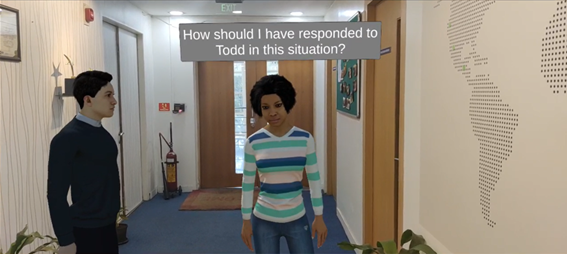
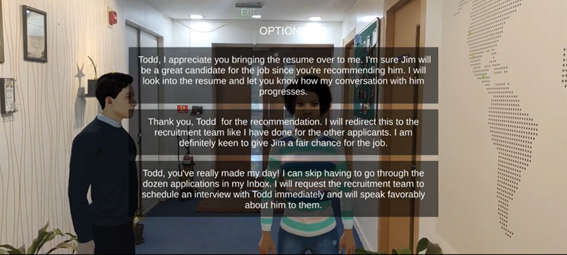
Learners also get to see how their choices measure up on a D&I gauge and a Bias gauge. Each choice in a multiple-choice question carries a different score. Learner responses are tracked. The gauges provide learners with immediate feedback about whether the response they selected leans towards a diversity and inclusion mindset, or more towards bias and prejudice.
The learning experience is scaffolded, which means that the feedback loops provide an additional layer of information to the learner, guiding them as they go. Through the feedback, learners receive deeper insights about their choices, which further sensitizes them to the underlying emotions of the character they’ve selected as well as the characters they’re interacting with in the scenarios.
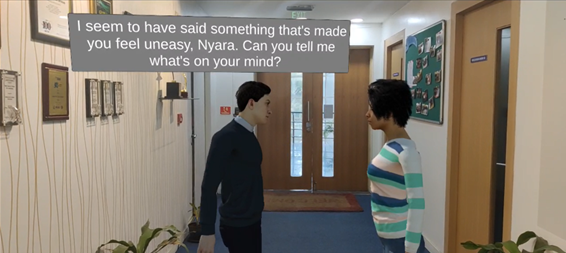
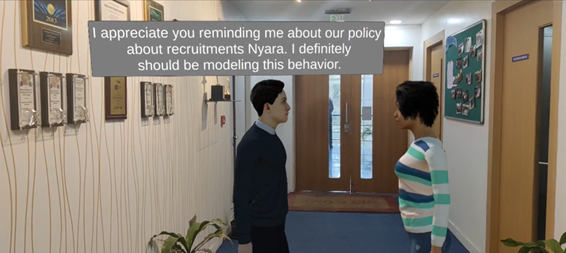
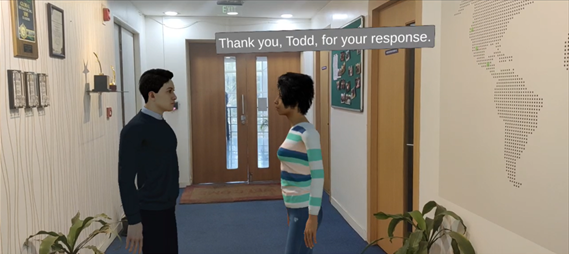
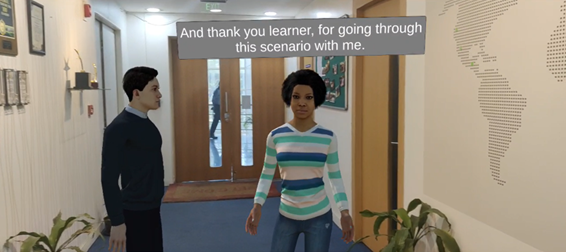
At the end of the learning process, learners are provided a comprehensive score and assessment of their performance in the learning journey. The scores give the learner a clear indication of their awareness levels and existing mindsets when it comes to diversity and inclusion. If they haven’t performed well, learners are encouraged to go back to the beginning and go through the learning experience again. Even if they have performed well, learners are encouraged to go back to the beginning and go through the learning experience again, however selecting another character this time.
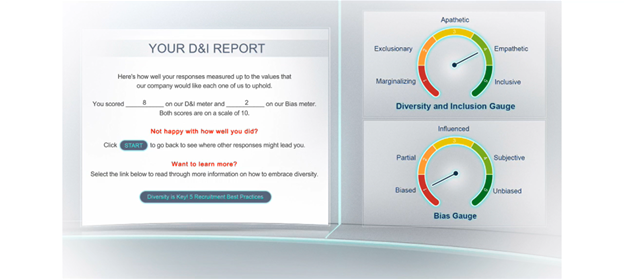
Why This Works
Experience, as we know, is crucial to learning. Benjamin Franklin once said- “Tell me and I forget, teach me and I may remember, involve me and I learn.” A multi-sensory, simulated experience like this one, places learners in the center of a narrative they can personally relate to. Being part of a story is far more powerful than hearing a story or watching it play out. It makes the learning experience all that more concrete.
Having the augmented characters fill the learners’ surroundings makes this a truly immersive and engaging learning experience. The fact that learners can move about with their mobile devices and get up close to the characters, also seeing them from different angles, truly amps up the engagement levels in the learning experience.
The net result is that the learner is locked in, becomes fully invested in the learning process, and walks away with a deeper identification and empathy towards the core concepts in the soft skills training, plus a greater overall appreciation for the learning experience.
There is no dearth of data that points to the fact that engaged, involved, and inspired learners are going to be transformed individuals, who in turn will become agents of transformation within their sphere of influence.
Where You Could Use Something like This
You might, by now, I whole-heartedly agree with the idea that placing a learner in someone’s shoes is by far the most effective way to help a learner develop empathy—and a range of other soft skills critical in the workplace such as communication, negotiation, problem-solving, conflict management, collaboration, persuasion, listening skills, relationship-building—the list can go on.
In the digital learning space, there are many ways that you could go about trying to achieve this goal. Even a low-fi but a well-scripted narrative with decision points, branching, feedback loops, and some level of gamification, would achieve good results. But there’s no denying that when learners are presented with immersive experiences, the learning takeaways are vastly greater.
Learners get to go beyond simply viewing characters in videos and animations to interacting with the characters in a safe space, and to being able to observe body language, expressions, and other non-verbal cues of the characters as they react and respond to the choices that the learners make in the scenarios. In a sense, immersive learning experiences awaken new neural pathways through a multi-sensory experience and thereby have a far greater impact on the training.
Learning in the metaverse is bound to deliver astounding learning results… in time. According to this Pew Research Center article, it might take another 20 years before the metaverse can deliver a much-more-refined and truly-fully immersive learning experience. But while we all wait for things to take shape in the metaverse, we have a pair of silver shoes available with us, and a medium in Augmented Reality, that can deliver fantastic returns on your learning investments.
Conclusion
Here are the top four reasons why you should consider Augmented Reality for your next soft skills training.
- No investment is required for end-user consumption – the mobile devices that most of your employees use come with pre-fitted AR core services. There is no need for any head-mounted displays to further augment the experience.
- Extensible learning solution – you can easily repurpose all the objects and assets that you create. Once you create a set of 3D characters, you can make minor cosmetic tweaks to them and reuse them across multiple scenarios. You also don’t have to be concerned with developing backgrounds and environments since the characters simply drop into the learners’ actual surroundings.
- Track learner activity and generate meaningful insights from the data – track specific interactions, decision points, tasks, events, and so on. Develop chronologies and patterns and predict learner behaviors based on different circumstances. Identify the most frequent challenges that your learners confront in different soft skill scenarios, and their readiness levels to make mindset changes and put into practice what they’ve learned.
- Extended use of learning artifacts – learning in Augmented Reality is not a once-and-done experience. Learners can be encouraged to revisit the learning experience and look at scenarios through different lenses, thereby developing well-rounded perspectives about different situations.
The use of Augmented Reality in corporate learning has far more applications apart from scenario-based learning, which could range from developing onboarding experiences to creating technical training of various kinds, and we will elucidate further on these in upcoming posts.
For now, we are here to help you with designing and developing impactful, immersive corporate soft skills training using our ‘silver shoes’ approach and leveraging Augmented Reality. Reach out to us to get started.
About Encora
Fast-growing tech companies partner with Encora to outsource product development and drive growth. Contact us to learn more about our software engineering capabilities.